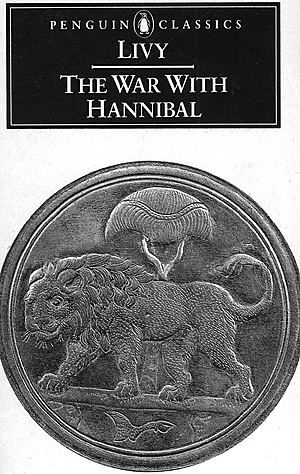Polybius notes that Hannibal marched 800 stades in 10 days "along the banks" of an unnamed river to reach the spot he called "ascent of the Alps." [Polybius III, 50]
Livy notes that the army "turned left to the territory of the Tricastini, proceeding thence past the borders of the Vocontii to the Tricorii and finding nothing to stop him until he reached the river Druentia." [Livy, XXI, 31]. The army crossed over the Druentia with some difficulty, and advanced over open ground to the foothills of the Alps, where a local tribe had blocked a defile. [Livy, XXI, 32].
The two differ because Livy has the Carthaginians advance across open ground, cross the Druentia River, cross more open ground, and reach the Ascent. Polybius moves the army along the river, generally across open ground, and then reach the Ascent without crossing a river. Livy states specific geographical and tribal names while Polybius often does not.
Bradford, following de Beer, defining the Island as the confluence of the Rhone and Aygues, argues the 800 stades (140km) indicates a line of march up the Rhone River until it reaches the Drome River, then a sharp right toward the Alps. The Drome curls south, necessitating a crossing before reaching the foothills. Prevas also votes for the Drome, noting it reconciles time and distances better than any other route.
Dodge contends the Island was at the Rhone and Isere Rivers, and thus the army crossed the Isere and followed the Rhone northward as far as present day Vienne, then cut eastward towards the Alps' foothills of Mont du Chat (at the town of St. Genix).
 He offers up the evidence of a silver shield found in 1714, with the "common Carthaginian device of a lion and palm engraved in a manner unlike Roman work but much like Carthaginian medals, at the village of Le Passage, which lies on a hill, where, you first get a view of the main chain of the Alps." (Hannibal, page 202) He calls it a votive offering for safe passage.
He offers up the evidence of a silver shield found in 1714, with the "common Carthaginian device of a lion and palm engraved in a manner unlike Roman work but much like Carthaginian medals, at the village of Le Passage, which lies on a hill, where, you first get a view of the main chain of the Alps." (Hannibal, page 202) He calls it a votive offering for safe passage.
Cover of The War with Hannibal shows the silver shield.
Lazenby plots Hannibal's route to the Isere River, then eastward towards Grenoble, cutting cross country to begin the ascent. He places the Gorges de la Bourne as the first ambush site, making Villard de Lans the captured town.
Dorey and Dudley assert Hannibal marched for 10 days along the Isere, then between Montmelian and Albertville, turned southeast up a tributary, the Arc River. Here is where the ascent was to begin.
Bath suggests that the turn to the "left" meant that Hannibal followed the left fork of the Island rivers, i.e., the Rhone, rather than the right fork, the Aygues. He proceeds up the Rhone to the Drome, and heads for the Alps, as de Beer wrote.
Caven follows the traditional route up the Rhone to the Isere.
Connolly has Hannibal follow the Isere to the Grenoble area, where the army turned south and headed up the Drac River. A gorge along the Drac is the choke point where the Allobroges blocked the Carthaginian army.
Hannibal Crosses the Alps A Route Examined and a Proposed Alternate Route
- Introduction
Survey of Classical Sources
Hannibal's March According to the Histories of Polybius and Livy
Polybius vs. Livy: Debate over Hannibal's March
Modern Historians: Route Acceptance and Rejection
Modern Historians: Rhone Crossing
Modern Historians: The Island
Modern Historians: From the Island to The Ascent of the Alps
Modern Historians: Ascent to the Alps to the Pass
Polybius vs. Livy: Short Bios
Hannibal's Line of March Considerations: Proposing a Route
Hannibal's March: A Proposed Alternate Route
Conclusion and Bibliography
Back to War Lore: The List
Back to Master Magazine List
© Copyright 2002 by Russ Lockwood.
This article appears in MagWeb (Magazine Web) on the Internet World Wide Web.
Other military history articles and gaming articles are available at http://www.magweb.com